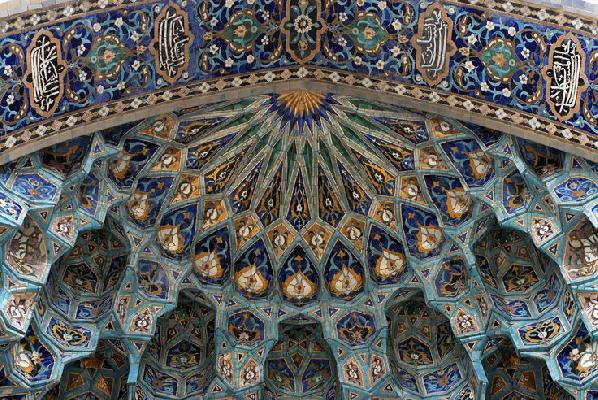The Origin and Early Development of Islamic Architecture

By: Siddiqua Shahnawaz
In the Qur’an the word Masjid, although used many times, is only applied to three specific buildings: the Masjid al Haram (ka’ba), the Masjid al Aqsa (Jerusalem) and the Masjid built at the oasis site called Quba, south-east of Medina. This was the first Masjid of Islam after the advent of Prophet Mohammad (s).
A Masjid is a place where one can feel the pulse of any Islamic community. From the earliest times, the Masjid has always been a religious and social centre for the community. Along with ritual prayers, a Masjid has been a place of learning both secular and religious studies, a place for commemorating important historic occasions as well as providing a platform for political pronouncements at Friday midday prayers. Therefore, besides its religious role, the range of activities traditionally associated with the Masjid was comparable to those previously associated with the Greek Agora or the Roman forum.
The Ka’ba
This is the most significant monument of Islam. Built originally by the Prophet Ibrahim (a.s.), this simple cubicle structure has gone through several renovations and expansion, although still maintaining its original style. This is the very structure that Muslims from around the globe face during ritual prayers. It is a place where Muslims converge for the pilgrimage of Haj. Among its other merits, it symbolizes the unity of Muslims, the simplicity of Islam as well as the dynamism of this faith. The Ka’ba was also the birthplace of Imam Ali (a.s.). It was a monument highly venerated by all from the time its foundation was laid.
Masjid al Aqsa
The earliest architectural monument of Islam that retains most of its original form is the dome of the rock (qubbat al-sakhrah) in Jerusalem. It was the first Qibla of Islam, that is, the place where all Muslims faced during their ritual prayers. Muslims believe it to be the spot from which Prophet Muhammad ascended to heaven. Among its other exquisite features, this masjis has mosaics depicting scrolling vines and flowers, jewels, and crowns in greens, blues and gold. It is among the most magnificent architectural monuments ever built.
Masjid at Quba
Dating from the time of the Prophet, the Masjid of Quba is considered the first mosque built by the Prophet and his followers. In the Qur’an (sura 9:108) there is a mention of the first public Masjid built at the place called Quba. Situated about 3 miles south-east of Medina, this oasis was the first place where the Prophet rested before entering Medina.
The mosque was a rectangular covered space measuring 54 x 63 cubits (approximately 26 x 30 m or 85 x 100 ft), built of mud brick and with date-palm trunks supporting the roof. It was in this mosque in the seventeenth month of the hijra, that the direction of the Qibla changed to face Mecca. Thus this Masjid also came to be known as Masjid al-Qiblatayn (i.e. with two qiblas).
First Masjid at Medina
The first Masjid at Medina was built by the Prophet and his followers. It was designed with utmost simplicity symbolising the purity and simplicity of the new way of life. The Prophet’s as well as the Ahlul Bayt’s homes opened onto the rectangular courtyard which served as the main hall of prayers.
For the comfort of the worshippers, a portico (zulla) made of palm trunks and branches was built on the north side of the courtyard, together with a smaller one (suffa or shed roof) which gave shelter to visitors who sometimes spent the night there. The zulla also served as a place for deliberations on community affairs, hence to this day the Masjid has retained its multivalent role as the place of prayer, social activities and political debate. From this modest beginning has developed the basic iconography of the Masjid.
Later on a minbar (pulpit) was added to address the gatherings at the mosque.
The call of prayer was given from the roof. Minarets, which are prominent architectural features of Masjids today, were added to Masjids much after the death of the Prophet when Islamic architecture evolved and synthesized with other cultures.
In the century after the death of the Prophet Muhammad (a.d.632), his Arab followers spread his teachings through Egypt and North Africa, as far west as Spain, and as far east as Sassanid Persia. Because of their rapid expansion and the flexibility of the Islamic architectural principles of the Arabian peninsula, the Muslims derived their unique style from synthesizing the arts of the regional areas along with traditional Arab styles.
The great strength of Islamic art as a whole lies in its ability to synthesize native design elements with imported ones.
While formal elaboration of Masjid design in Muslim history has created totally different concepts of architecture and
regional styles, the image of the archetype remained unchanged : the concept of a courtyard (sahn) and a sanctuary (haram) which essentially consists of a hypostyle hall (i.e., an interior space with multiple supports for the roof) has survived to this day. Such features are examples of architectural symbolism that retain their validity in a practical sense.
Calligraphy
Certain other unique and outstanding features in Islamic art and architecture, like calligraphy and abstract decoration were born and evolved while Islam reached different regions of the world. Such features are as varied as the regions themselves and exist till
